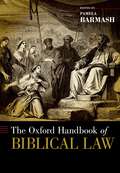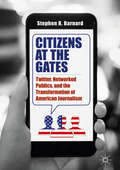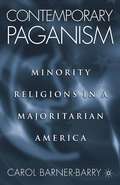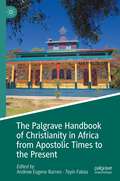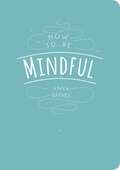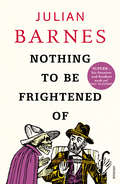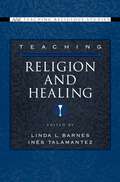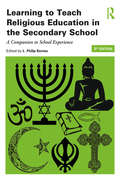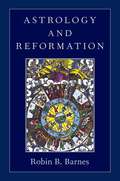- Table View
- List View
Mormons and the Bible: The Place of the Latter-day Saints in American Religion
by Philip L. BarlowPhilip L. Barlow offers an in-depth analysis of the approaches taken to the Bible by major Mormon leaders, from its beginnings to the present. He shows that Mormon attitudes toward the Bible comprise an extraordinary mix of conservative, liberal, and radical ingredients: an almost fundamentalist adherence to the King James Version co-exists with belief in the possibility of new revelation and surprising ideas about the limits of human language. Barlow's exploration takes important steps toward unraveling the mystery of this quintessential American religious phenomenon. This updated edition of Mormons and the Bible includes an extended bibliography and a new preface, casting Joseph Smith's mission into a new frame and treating evolutions in Mormonism's biblical usage in recent decades.
Mormons and the Bible: The Place of the Latter-day Saints in American Religion
by Philip L. BarlowPhilip L. Barlow offers an in-depth analysis of the approaches taken to the Bible by major Mormon leaders, from its beginnings to the present. He shows that Mormon attitudes toward the Bible comprise an extraordinary mix of conservative, liberal, and radical ingredients: an almost fundamentalist adherence to the King James Version co-exists with belief in the possibility of new revelation and surprising ideas about the limits of human language. Barlow's exploration takes important steps toward unraveling the mystery of this quintessential American religious phenomenon. This updated edition of Mormons and the Bible includes an extended bibliography and a new preface, casting Joseph Smith's mission into a new frame and treating evolutions in Mormonism's biblical usage in recent decades.
Islam and Health Policies Related to HIV Prevention in Malaysia (SpringerBriefs in Public Health)
by Sima Barmania Michael J. ReissThis salient text presents a culturally aware public health approach to the HIV epidemic in Malaysia, a country emblematic of the Muslim world's response to the crisis. It explores complex interactions of religion with health as a source of coping as well as stigma and denial, particularly as Islam plays a central role in Malaysian culture, politics, and policy. At the heart of the book, a groundbreaking study analyzes attitudes and behaviors toward prevention among diverse people living with HIV, faith leaders, and government health officials. From these findings, readers gain insight into how health professionals, policymakers, and organizations can create appropriate prevention programs in Malaysia, with implications for other Muslim countries. This timely volume: Situates Malaysia and the Asian Pacific region in the context of the HIV epidemic.Analyzes ways Islamic beliefs can shape perceptions of HIV and prevention policy.Reviews a unique study of stakeholder opinions and practices regarding HIV.Discusses the consequences of Islamic rulings on sex outside marriage.Offers recommendations for effective HIV prevention practice and policy. Islam and Health Policies Related to HIV Prevention in Malaysia is of immediate relevance to researchers studying HIV prevention, social aspects of religion, sexuality, and sex education. Policymakers in health promotion and health education as well as graduate students in sex education, sociology, psychology, and cultural studies should also find it useful.
The Laws of Hammurabi: At the Confluence of Royal and Scribal Traditions
by Pamela BarmashAmong the best-known and most esteemed people known from antiquity is the Babylonian king Hammurabi. His fame and reputation are due to the collection of laws written under his patronage. This book offers an innovative interpretation of the Laws of Hammurabi. Ancient scribes would demonstrate their legal flair by composing statutes on a set of traditional cases, articulating what they deemed just and fair. The scribe of the Laws of Hammurabi advanced beyond earlier scribes in composing statutes that manifest systematization and implicit legal principles, and inserted the Laws of Hammurabi into the form of a royal inscription, shrewdly reshaping the genre. This tradition of scribal improvisation on a set of traditional cases continued outside of Mesopotamia. It influenced biblical law and the law of the Hittite empire significantly. The Laws of Hammurabi was also witness to the start of another stream of intellectual tradition. It became the subject of formal commentaries, marking a profound cultural shift. Scribes related to it in ways that diverged from prior attitudes; it became an object of study and of commentary, a genre that names itself as dependent on another text. The famous Laws of Hammurabi is here given the extensive attention it continues to merit.
The Laws of Hammurabi: At the Confluence of Royal and Scribal Traditions
by Pamela BarmashAmong the best-known and most esteemed people known from antiquity is the Babylonian king Hammurabi. His fame and reputation are due to the collection of laws written under his patronage. This book offers an innovative interpretation of the Laws of Hammurabi. Ancient scribes would demonstrate their legal flair by composing statutes on a set of traditional cases, articulating what they deemed just and fair. The scribe of the Laws of Hammurabi advanced beyond earlier scribes in composing statutes that manifest systematization and implicit legal principles, and inserted the Laws of Hammurabi into the form of a royal inscription, shrewdly reshaping the genre. This tradition of scribal improvisation on a set of traditional cases continued outside of Mesopotamia. It influenced biblical law and the law of the Hittite empire significantly. The Laws of Hammurabi was also witness to the start of another stream of intellectual tradition. It became the subject of formal commentaries, marking a profound cultural shift. Scribes related to it in ways that diverged from prior attitudes; it became an object of study and of commentary, a genre that names itself as dependent on another text. The famous Laws of Hammurabi is here given the extensive attention it continues to merit.
The Oxford Handbook of Biblical Law (Oxford Handbooks)
by Pamela BarmashMajor innovations have occurred in the study of biblical law in recent decades. The legal material of the Pentateuch has received new interest with detailed studies of specific biblical passages. The comparison of biblical practice to ancient Near Eastern customs has received a new impetus with the concentration on texts from actual ancient legal transactions. The Oxford Handbook of Biblical Law provides a state of the art analysis of the major questions, principles, and texts pertinent to biblical law. The thirty-three chapters, written by an international team of experts, deal with the concepts, significant texts, institutions, and procedures of biblical law; the intersection of law with religion, socio-economic circumstances, and politics; and the reinterpretation of biblical law in the emerging Jewish and Christian communities. The volume is intended to introduce non-specialists to the field as well as to stimulate new thinking among scholars working in biblical law.
Citizens at the Gates: Twitter, Networked Publics, and the Transformation of American Journalism
by Stephen R. BarnardDrawing insights from nearly a decade of mixed-method research, Stephen R. Barnard analyzes Twitter’s role in the transformation of American journalism. As the work of media professionals grows increasingly hybrid, Twitter has become an essential space where information is shared, reporting methods tested, and power contested. In addition to spelling opportunity for citizen media activism, the normalization of digital communication adds new channels of influence for traditional thought leaders, posing notable challenges for the future of journalism and democracy. In his analyses of Twitter practices around newsworthy events—including the Boston Marathon bombing, protests in Ferguson, Missouri, and the election of Donald Trump—Barnard brings together conceptual and theoretical lenses from multiple academic disciplines, bridging sociology, journalism, communication, media studies, science and technology studies, and political science.
Citizens at the Gates: Twitter, Networked Publics, and the Transformation of American Journalism
by Stephen R. BarnardDrawing insights from nearly a decade of mixed-method research, Stephen R. Barnard analyzes Twitter’s role in the transformation of American journalism. As the work of media professionals grows increasingly hybrid, Twitter has become an essential space where information is shared, reporting methods tested, and power contested. In addition to spelling opportunity for citizen media activism, the normalization of digital communication adds new channels of influence for traditional thought leaders, posing notable challenges for the future of journalism and democracy. In his analyses of Twitter practices around newsworthy events—including the Boston Marathon bombing, protests in Ferguson, Missouri, and the election of Donald Trump—Barnard brings together conceptual and theoretical lenses from multiple academic disciplines, bridging sociology, journalism, communication, media studies, science and technology studies, and political science.
Contemporary Paganism: Minority Religions in a Majoritarian America
by C. Barner-BarryThis book explores the legal bias in the United States against Paganism and other non-Christian religions. Despite being one of the most religiously diverse countries in the world, the U.S. legal system developed when the population was predominantly Christian. Built into the law is the tacit assumption that all religions and religious practices resemble Christianity. Using the Pagans as a case study, Barner-Barry shows how their experiences demonstrate that both the law affecting nondominant religions and the judiciary that interprets this law are significantly biased in favor of the dominant religion, Christianity. This creates legal problems, as well as problems of intolerance, for religions with significantly different practices. Special attention is given to a series of Supreme Court decisions interpreting the Freedom of Religion Clause in terms of neutrality and interpreting the Establishment Clause loosely and its impact on nondominant religions in the US.
The Palgrave Handbook of Christianity in Africa from Apostolic Times to the Present
by Andrew Eugene Barnes Toyin FalolaThis comprehensive Handbook provides chapter length surveys of the history of Christian missions and Christian churches on the African continent since the time of Christ. Africa is rapidly becoming the most Christianized region of the world. While common narratives about Christianity tend to present Christianity as a set of ideas and beliefs imposed on Africa from the outside, such narratives hold little meaning for African Christians or for those seeking to understand Christianity in Africa as an indigenous faith. The aim of the Handbook is to propose a set of scholarly starting points for a new set of narratives. The chapters collected here communicate an idea of Christianity as it has been embraced among African peoples at particular historical moments. It therefore grants voice to the various strands of African Christianity on their own terms, and offers scholarly study of what these voices teach us about how the world’s most adhered to religion is practiced and understood on the continent of Africa.
How to Be Mindful
by Anna BarnesWould you like to feel less stressed, live more calmly and be more content? The simple ideas that mindfulness teaches can help you achieve all these things, and more! Bursting with tips, centring statements and activities, How to Be Mindful will provide you with everything you need to make every day full of gratitude and peace.
Death: Vintage Minis (Vintage Minis)
by Julian BarnesWhen it comes to death, is there ever a best case scenario? In this disarmingly witty book, Julian Barnes confronts our unending obsession with the end. He reflects on what it means to miss God, whether death can be good for our careers and why we eventually turn into our parents. Barnes is the perfect guide to the weirdness of the only thing that binds us all.Selected from the book Nothing to be Frightened Of by Julian BarnesVINTAGE MINIS: GREAT MINDS. BIG IDEAS. LITTLE BOOKS.A series of short books by the world’s greatest writers on the experiences that make us humanAlso in the Vintage Minis series:Calm by Tim ParksDrinking by John CheeverBabies by Anne EnrightPsychedelics by Aldous Huxley
Nothing To Be Frightened Of
by Julian Barnes'I don't believe in God, but I miss Him.' Julian Barnes' new book is, among many things, a family memoir, an exchange with his philosopher brother, a meditation on mortality and the fear of death, a celebration of art, an argument with and about God, and a homage to the French writer Jules Renard. Though he warns us that 'this is not my autobiography', the result is a tour of the mind of one of our most brilliant writers.
A Vast Bundle of Opportunities: An Exploration of Creativity in Personal Life and Community (Routledge Revivals)
by Kenneth C. BarnesThe conventional view of religion is that the basic truths were settled long ago, that all we have to do is to accept them and behave accordingly. Essentially then, there is no room for originality. To be religious we have to be followers, adherents, to be convinced, addicted, to be in a position to say: we are right, you are wrong. In A Vast Bundle of Opportunities, originally published in 1975, Kenneth Barnes maintains that this is a sterile condition of mind. Religion is not a separate kind of experience; it includes our whole selves and all that we do. It follows that if art and science can be creative and originative, so also must religion be, if it is real. If it is the Christian religion we are thinking of, then to try to ‘imitate’ Jesus is to kill him stone dead. To make him an ideal is to put him away. But to respond to him is to come alive as creators and originators. The writer, as the founder of an unusual kind of boarding school – Wennington School, Wetherby – knows what it is like to live in the midst of incessant enterprising activity; in his own life he knows what it feels like to be a scientist, an artist, a craftsman. He asks if there are ways we can deliberately choose by which we can become originators. He takes the philosophy of John Macmurrray to show what freedom could mean to us, and the more recent writings of Arthur Koestler and Edouard de Bono to suggest that the obvious development of creativeness in science can be encouraged in the total approach to life and human problems. Life then becomes an experience of endless discovery, a continual opening up of possibilities.
A Vast Bundle of Opportunities: An Exploration of Creativity in Personal Life and Community (Routledge Revivals)
by Kenneth C. BarnesThe conventional view of religion is that the basic truths were settled long ago, that all we have to do is to accept them and behave accordingly. Essentially then, there is no room for originality. To be religious we have to be followers, adherents, to be convinced, addicted, to be in a position to say: we are right, you are wrong. In A Vast Bundle of Opportunities, originally published in 1975, Kenneth Barnes maintains that this is a sterile condition of mind. Religion is not a separate kind of experience; it includes our whole selves and all that we do. It follows that if art and science can be creative and originative, so also must religion be, if it is real. If it is the Christian religion we are thinking of, then to try to ‘imitate’ Jesus is to kill him stone dead. To make him an ideal is to put him away. But to respond to him is to come alive as creators and originators. The writer, as the founder of an unusual kind of boarding school – Wennington School, Wetherby – knows what it is like to live in the midst of incessant enterprising activity; in his own life he knows what it feels like to be a scientist, an artist, a craftsman. He asks if there are ways we can deliberately choose by which we can become originators. He takes the philosophy of John Macmurrray to show what freedom could mean to us, and the more recent writings of Arthur Koestler and Edouard de Bono to suggest that the obvious development of creativeness in science can be encouraged in the total approach to life and human problems. Life then becomes an experience of endless discovery, a continual opening up of possibilities.
Religious Education: Educating for Diversity (Key Debates in Educational Policy)
by L. Philip Barnes Andrew Davis J. Mark HalsteadReligious Education: Educating for Diversity raises issues that are central to the theory and practice of education, and in particular religious education, in modern liberal democracies characterized by diversity in its different forms. What kind of religious education is best equipped both to challenge prejudice and intolerance in society and to develop responsible and respectful relationships between people from different communities or with different commitments? Two eminent educators address this question and propose contrasting answers. Attention is given to the aims of education and the contribution of religious education to the curriculum; historical forms of religious education; the nature of diversity in society; the roots of prejudice; different methodologies in religious education and their philosophical and religious commitments; and to positive strategies to enable religious education to realise its potential and contribute to the social and moral aims of liberal education.
Religious Education: Educating for Diversity (Key Debates in Educational Policy)
by L. Philip Barnes Andrew Davis J. Mark HalsteadReligious Education: Educating for Diversity raises issues that are central to the theory and practice of education, and in particular religious education, in modern liberal democracies characterized by diversity in its different forms. What kind of religious education is best equipped both to challenge prejudice and intolerance in society and to develop responsible and respectful relationships between people from different communities or with different commitments? Two eminent educators address this question and propose contrasting answers. Attention is given to the aims of education and the contribution of religious education to the curriculum; historical forms of religious education; the nature of diversity in society; the roots of prejudice; different methodologies in religious education and their philosophical and religious commitments; and to positive strategies to enable religious education to realise its potential and contribute to the social and moral aims of liberal education.
Teaching Religion and Healing (AAR Teaching Religious Studies)
by Linda L. BarnesThe study of medicine and healing traditions is well developed in the discipline of anthropology. Most religious studies scholars, however, continue to assume that "medicine" and "biomedicine" are one and the same and that when religion and medicine are mentioned together, the reference is necessarily either to faith healing or bioethics. Scholars of religion also have tended to assume that religious healing refers to the practices of only a few groups, such as Christian Scientists and pentecostals. Most are now aware of the work of physicians who attempt to demonstrate positive health outcomes in relation to religious practice, but few seem to realize the myriad ways in which healing pervades virtually all religious systems. This volume is designed to help instructors incorporate discussion of healing into their courses and to encourage the development of courses focused on religion and healing. It brings together essays by leading experts in a range of disciplines and addresses the role of healing in many different religious traditions and cultural communities. An invaluable resource for faculty in anthropology, religious studies, American studies, sociology, and ethnic studies, it also addresses the needs of educators training physicians, health care professionals, and chaplains, particularly in relation to what is referred to as "cultural competence" - the ability to work with multicultural and religiously diverse patient populations.
Waiting on Grace: A Theology of Dialogue
by Michael BarnesWhereas much theology of religions regards 'the other' as a problem to be solved, this book begins with a Church called to witness to its faith in a multicultural world by practising a generous yet risky hospitality. A theology of dialogue takes its rise from the Christian experience of being-in-dialogue. Taking its rise from the biblical narrative of encounter, call and response, such a theology cannot be fully understood without reference to the matrix of faith that Christians share in complex ways with the Jewish people. The contemporary experience of the Shoah, the dominating religious event of the 20th Century, has complexified that relationship and left an indelible mark on the religious sensibility of both Jews and Christians. Engaging with a range of thinkers, from Heschel, Levinas and Edith Stein who were all deeply affected by the Shoah, to Metz, Panikkar and Rowan Williams, who are always pressing the limits of what can and cannot be said with integrity about the self-revealing Word of God, this book shows how Judaism is a necessary, if not sufficient, source of Christian self-understanding. What is commended by this foundational engagement is a hope-filled 'waiting on grace' made possible by virtues of empathy and patience. A theology of dialogue focuses not on metaphysical abstractions but on biblical forms of thought about God's presence to human beings which Christians share with Jews and, under the continuing guidance of the Spirit of Christ, learn to adapt to a whole range of contested cultural and political contexts.
Waiting on Grace: A Theology of Dialogue
by Michael BarnesWhereas much theology of religions regards 'the other' as a problem to be solved, this book begins with a Church called to witness to its faith in a multicultural world by practising a generous yet risky hospitality. A theology of dialogue takes its rise from the Christian experience of being-in-dialogue. Taking its rise from the biblical narrative of encounter, call and response, such a theology cannot be fully understood without reference to the matrix of faith that Christians share in complex ways with the Jewish people. The contemporary experience of the Shoah, the dominating religious event of the 20th Century, has complexified that relationship and left an indelible mark on the religious sensibility of both Jews and Christians. Engaging with a range of thinkers, from Heschel, Levinas and Edith Stein who were all deeply affected by the Shoah, to Metz, Panikkar and Rowan Williams, who are always pressing the limits of what can and cannot be said with integrity about the self-revealing Word of God, this book shows how Judaism is a necessary, if not sufficient, source of Christian self-understanding. What is commended by this foundational engagement is a hope-filled 'waiting on grace' made possible by virtues of empathy and patience. A theology of dialogue focuses not on metaphysical abstractions but on biblical forms of thought about God's presence to human beings which Christians share with Jews and, under the continuing guidance of the Spirit of Christ, learn to adapt to a whole range of contested cultural and political contexts.
Stages Of Thought: The Co-evolution Of Religious Thought And Science
by Michael Horace BarnesInStages of Thought, Michael Barnes examines a pattern of cognitive development that has evolved over thousands of years--a pattern manifest in both science and religion. He describes how the major world cultures built upon our natural human language skills to add literacy, logic, and, now, a highly critical self-awareness. In tracing the histories of both scientific and religious thought, Barnes shows why we think the way that we do today. Although religious and scientific modes of thought are often portrayed as contradictory-one is highly rational while the other appeals to tradition and faith-Barnes argues that they evolved together and are actually complementary. Using the developmental thought of Piaget, he argues that cultures develop like individuals in that both learn easier cognitive skills first and master the harder ones later. This is especially true, says Barnes, because the harder ones often require first the creation of cognitive technology like writing or formal logic as well as the creation of social institutions that teach and sustain those skills. Barnes goes on to delineate the successive stages of the co-evolution of religious and scientific thought in the West, from the preliterate cultures of antiquity up to the present time. Along the way, he covers topics such as the impact of literacy on human modes of thought; the development of formalized logic and philosophical reflections; the emergence of an explicitly rational science; the birth of formal theologies; and, more recently, the growth of modern empirical science. This groundbreaking book offers a thorough and persuasive argument in favor of the development of modes of thought across cultures. It will serve as an invaluable resource for historians of religion, philosophers and historians of science, and anyone interested in the relationship between religion and science.
Stages of Thought: The Co-Evolution of Religious Thought and Science
by Michael Horace BarnesIn Stages of Thought, Michael Barnes examines a pattern of cognitive development that has evolved over thousands of years--a pattern manifest in both science and religion. He describes how the major world cultures built upon our natural human language skills to add literacy, logic, and, now, a highly critical self-awareness. In tracing the histories of both scientific and religious thought, Barnes shows why we think the way that we do today. Although religious and scientific modes of thought are often portrayed as contradictory-one is highly rational while the other appeals to tradition and faith-Barnes argues that they evolved together and are actually complementary. Using the developmental thought of Piaget, he argues that cultures develop like individuals in that both learn easier cognitive skills first and master the harder ones later. This is especially true, says Barnes, because the harder ones often require first the creation of cognitive technology like writing or formal logic as well as the creation of social institutions that teach and sustain those skills. Barnes goes on to delineate the successive stages of the co-evolution of religious and scientific thought in the West, from the preliterate cultures of antiquity up to the present time. Along the way, he covers topics such as the impact of literacy on human modes of thought; the development of formalized logic and philosophical reflections; the emergence of an explicitly rational science; the birth of formal theologies; and, more recently, the growth of modern empirical science. This groundbreaking book offers a thorough and persuasive argument in favor of the development of modes of thought across cultures. It will serve as an invaluable resource for historians of religion, philosophers and historians of science, and anyone interested in the relationship between religion and science.
Learning to Teach Religious Education in the Secondary School: A Companion to School Experience (Learning to Teach Subjects in the Secondary School Series)
by Philip L. Barnes L. Philip BarnesThe third edition of Learning to Teach Religious Education in the Secondary School draws together insights from current educational theory and the best contemporary classroom teaching and learning, and suggests tasks, activities and further reading designed to enhance the quality of initial school experience for the student teacher. This third edition has all new content and contributors, which take account of recent developments in the subject. Key themes addressed include: the aims and place of religious education in the curriculum; recent policy developments; developing lesson plans and schemes of work; the role of language and talk in religious education; spirituality and spiritual development; assessment in religious education; religious education at both Key Stage 4 and at A Level; religion education in relation to moral education; the role of computers; inclusion; professional development. Learning to Teach Religious Education in the Secondary School is designed to provide student teachers with a comprehensive and accessible introduction to teaching religious education in the secondary school.
Astrology and Reformation
by Robin B. BarnesWinner of the 2016 Roland H. Bainton Book Prize of the Sixteenth Century Society and Conference During the sixteenth century, no part of the Christian West saw the development of a more powerful and pervasive astrological culture than the very home of the Reformation movement--the Protestant towns of the Holy Roman Empire. While most modern approaches to the religious and social reforms of that age give scant attention to cosmological preoccupations, Robin Barnes argues that astrological concepts and imagery played a key role in preparing the ground for the evangelical movement sparked by Martin Luther in the 1520s, as well as in shaping the distinctive characteristics of German evangelical culture over the following century. Spreading above all through cheap printed almanacs and prognostications, popular astrology functioned in paradoxical ways. It contributed to an enlarged and abstracted sense of the divine that led away from clericalism, sacramentalism, and the cult of the saints; at the same time, it sought to ground people more squarely in practical matters of daily life. The art gained unprecedented sanction from Luther's closest associate, Philipp Melanchthon, whose teachings influenced generations of preachers, physicians, schoolmasters, and literate layfolk. But the apocalyptic astrology that came to prevail among evangelicals involved a perpetuation, even a strengthening, of ties between faith and cosmology, which played out in beliefs about nature and natural signs that would later appear as rank superstitions. Not until the early seventeenth century did Luther's heirs experience a "crisis of piety" that forced preachers and stargazers to part ways. Astrology and Reformation illuminates an early modern outlook that was both practical and prophetic; a world that was neither traditionally enchanted nor rationally disenchanted, but quite different from the medieval world of perception it had displaced.



